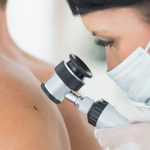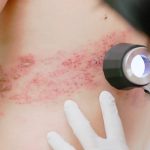Rosacea is a common skin condition characterized by the tendency to blush easily. Many people do not recognize the symptoms of this skin condition, so they do not realize they have it. It affects over 16 million Americans, according to the National Rosacea Society. Here is your guide to understanding this condition, its causes, symptoms and treatments.
What is rosacea?
Rosacea is a skin condition that causes facial redness and can appear differently depending on the person. Rosacea symptoms include:
- Facial redness in the central part of the face
- Visible blood vessels on the nose and cheeks
- Red, sometimes pus-filled bumps that appear swollen
- Facial tenderness and heat
- Eye issues, including dryness, irritation, swelling and red eyelids
- Rhinophyma, or enlarged nose from thickening skin
It can occur in anyone but is most commonly found in middle-aged women who have fair skin. It is often mistaken for an allergic reaction or acne. The condition can have bad flare-ups, then subside in some patients.
What are the different types of rosacea?
Because the condition can have various signs and symptoms, doctors have created four subtypes. Each subtype presents in specific ways and requires different treatments. Some patients may have more than one subtype occurring at the same time. More about these subtypes:
Erythematotelangiectatic (ETR) causes redness, visible small blood vessels and flushing in the center of the face. Patients who suffer from ETR commonly experience rough, dry, swollen skin or scaling. Their skin may be extremely sensitive and tend to sting or burn. Patients with ETR may blush more easily than others.
Papulopustular is common in middle-aged women. This subtype causes acne-like breakouts where the skin is very red. These breakouts will come and go, causing oily and sensitive skin when visible. Those who suffer from this type also experience plaques or raised patches of skin.
Phymatous, although rare, can cause skin thickening or bumpy skin, referred to as rhinophyma. This type appears in men more than women. People with this type of rosacea may have large pores, oily skin and visible, broken blood vessels. Patients often have symptoms of other types of rosacea before these symptoms appear.
Ocular is the final subtype that affects your eyes. It causes watery, bloodshot eyes that feel gritty, like sand in the eye. Eyes become very sensitive and will burn, sting, and feel dry and itchy.
Ocular rosacea can also cause what looks like a sty on the eye. These symptoms will affect a patient’s ability to see as well as they did before.
What causes this condition?
The cause of rosacea is unknown. Scientists have found that it could be a combination of environmental factors and heredity. Multiple factors can trigger or aggravate the condition.
Some triggers increase the blood flow to the skin’s surface, which can irritate your skin. Common triggers may include:
- Alcohol
- Smoking
- Extreme temperatures
- Wind and sunlight
- Extreme emotions
- Some cosmetics
- Exercise
- Spicy foods and hot drinks
According to studies, some medications that dilate blood vessels, such as blood pressure drugs, can trigger rosacea.
What is the most effective treatment?
There is no cure for rosacea, but many effective treatments help control symptoms for people with rosacea. The type and duration of treatment depend on the severity of your case.
The most effective treatment is to avoid triggers. Know what causes your flare-ups and work to avoid those triggers. Protect your face by applying at least SPF 30 sunscreen daily, which can keep triggers at bay.
Many medications and therapies can reduce the redness caused by this condition. Recent studies have shown that a drug called brimonidine controls redness by constricting blood vessels.
Other topical medications to help the appearance of mild cases include azelaic acid and metronidazole. See your dermatologist for more information about medications that are a good fit for your skin. Some may require long-term use.
Laser treatment has successfully reduced redness and enlarged blood vessels in patients. Columbia Skin Clinic offers intense pulsed light therapy and dermabrasion, which can help treat rhinophyma. We can also help treat rosacea by providing advice on reducing triggers.
Rosacea treatment in Columbia
If you see signs and symptoms of rosacea, seek treatment. The highly trained staff at Columbia Skin Clinic can help you cope with this skin condition. We will develop a treatment plan that works best for your skin type and lifestyle. Book an appointment today at one of our three convenient locations in Columbia, Irmo and Camden.






